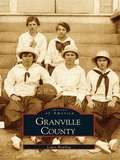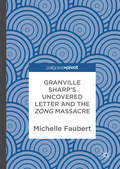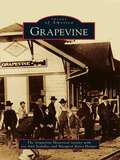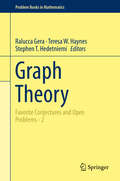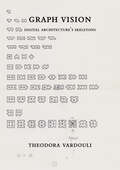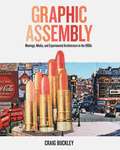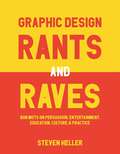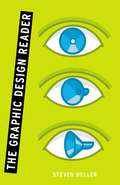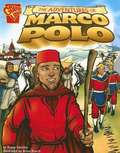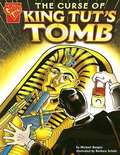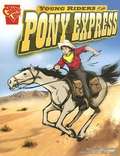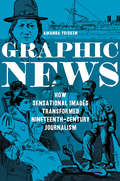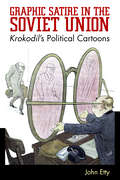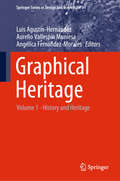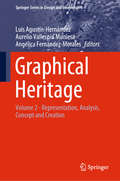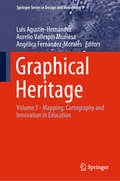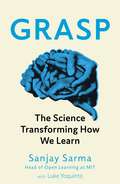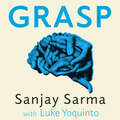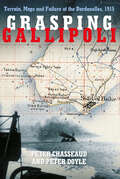- Table View
- List View
Granville County: Looking Back (Images of America)
by Lewis BowlingNorth Carolina's historic county of Granville, nestled in the rolling hills of the Piedmont along the North Carolina-Virginia border, was named for Lord John Carteret, Earl of Granville, in the mid-18th century. The home to Declaration of Independence signer John Penn, Granville was once recognized for its educational centers and tobacco-based economy. Although the county has become more industrial than agricultural in recent years, Granvillians hold fast to their rural heritage, honoring and remembering the hardships early settlers triumphantly faced to mold a better life for both themselves and future generations.Images of America: Granville County is a pictorial retrospective illustrating many of the county's achievements, both large and small. Vintage photographs, highlighted by informative captions, relay the arrival of the railroad and the towns of Creedmoor, Stem, and Stovall, which grew up along the tracks; the development of Oxford, the county seat; the construction and usage of Camp Butner; and various other events from the late 19th and 20th centuries. Images also feature past residents, offering longtime families the chance to see loved ones and newcomers the opportunity to connect faces with local names.
Granville Sharp's Uncovered Letter and the Zong Massacre
by Michelle FaubertThis book delineates the discovery of a previously unknown manuscript of a letter from Granville Sharp, the first British abolitionist, to the “Lords Commissioners of the Admiralty.” In the letter, Sharp demands that the Admiralty bring murder charges against the crew of the Zong for forcing 132 enslaved Africans overboard to their deaths. Uncovered by Michelle Faubert at the British Library in 2015, the letter is reproduced here, accompanied by her examination of its provenance and significance for the history of slavery and abolition. As Faubert argues, the British Library manuscript is the only fair copy of Sharp’s letter, and extraordinary evidence of Sharp’s role in the abolition of slavery.
Grape And Canister: The Story Of The Field Artillery Of The Army Of The Potomac, 1861 To 1865
by L. Vanloan NaisawaldIncludes - 18 maps and 6 illustrations"The role of the field artillery in the Civil War is often overlooked in favor of the more romantic views of great cavalry commanders or infantrymen. But the reality was that without the field artillery, many of the decisive battles won by the Army of the Potomac most likely would have resulted in defeat and/or destruction. Grape and Canister, first published in 1960, has since become a classic and remains the definitive study of the field artillery of the Army of the Potomac."-Print ed.
Grapes Of Wrath
by Boyd CableIT is possible that this book may be taken for an actual account of the Somme battle, but I warn readers that although it is in the bulk based on the fighting there and is no doubt colored by the fact that the greater part of it was written in the Somme area or between visits to it, I make no claim for it as history or as an historical account. My ambition was the much lesser one of describing as well as I could what a Big Push is like from the point of view of an ordinary average infantry private, of showing how much he sees and knows and suffers in a, great battle, of giving a glimpse perhaps of the spirit that animates the New Armies, the endurance that has made them more than a match for the Germans, the acceptance of appalling and impossible horrors as the work-a-day business and routine of battle, the discipline and training that has fused such a mixture of material into tempered fighting metal.For the tale itself, I have tried to put into words merely the sort of story that might and could be told by thousands of our men to-day. I hope, in fact, I have so "told the tale" that such men as I have written of may be able to put this book in your hands and say: "This chapter just describes our crossing the open," or "That is how we were shelled," or "I felt the same about my Blighty one."
Grapevine (Images of America)
by Grapevine Historical SocietyThe town of Grapevine was formed when a small group of pioneers settled together on the Grape Vine Prairie in the 1840s and 1850s. The first settlers came for the promise of land ownership and a better life, and the Grape Vine Springs and rich soil yielded good harvests and subsequent prosperity. When the Cotton Belt Railroad arrived in 1888, it helped establish the town as a permanent agricultural trade center servicing the entire region. The Civil War and World Wars I and II interrupted the town's normal activities, but the citizens rallied in support of their state and country. Two major construction projects in the 1950s and 1960s transformed the future of Grapevine: the Grapevine Dam and Reservoir and the Dallas-Fort Worth International Airport. In the 1970s, local historians realized the wealth within the city's past, and leaders took steps to protect and preserve it so that today people from all over the world come to see this quaint little prairie town.
Graph Theory: Favorite Conjectures And Open Problems - 1 (Problem Books in Mathematics)
by Ralucca Gera Teresa W. Haynes Stephen T. HedetniemiThis second volume in a two-volume series provides an extensive collection of conjectures and open problems in graph theory. It is designed for both graduate students and established researchers in discrete mathematics who are searching for research ideas and references. Each chapter provides more than a simple collection of results on a particular topic; it captures the reader’s interest with techniques that worked and failed in attempting to solve particular conjectures. The history and origins of specific conjectures and the methods of researching them are also included throughout this volume. Students and researchers can discover how the conjectures have evolved and the various approaches that have been used in an attempt to solve them. An annotated glossary of nearly 300 graph theory parameters, 70 conjectures, and over 600 references is also included in this volume. This glossary provides an understanding of parameters beyond their definitions and enables readers to discover new ideas and new definitions in graph theory. The editors were inspired to create this series of volumes by the popular and well-attended special sessions entitled “My Favorite Graph Theory Conjectures,” which they organized at past AMS meetings. These sessions were held at the winter AMS/MAA Joint Meeting in Boston, January 2012, the SIAM Conference on Discrete Mathematics in Halifax in June 2012, as well as the winter AMS/MAA Joint Meeting in Baltimore in January 2014, at which many of the best-known graph theorists spoke. In an effort to aid in the creation and dissemination of conjectures and open problems, which is crucial to the growth and development of this field, the editors invited these speakers, as well as other experts in graph theory, to contribute to this series.
Graph Vision: Digital Architecture’s Skeletons
by Theodora VardouliHow a protean mathematical object, the graph, ushered in new images, tools, and infrastructures for design and catalyzed a digital future for architecture.In Graph Vision, Theodora Vardouli offers a fresh history of architecture&’s early entanglements with modern mathematics and digital computing by focusing on a hidden protagonist: the graph. Fueled by iconoclastic sentiments and skepticism of geometric depiction, architects, she explains, turned to the skeletal underpinnings of their work, and with it the graph, as a site of representation, operation, and political possibility. Taking the reader on an enthralling journey through a polyvalent mathematical entity, Vardouli combines close readings of graphs&’ architectural manifestations as images, tools, and infrastructures for design with original archival work on research centers that spearheaded mathematical and computational approaches to architecture.Structured thematically, Graph Vision weaves together archival findings on influential research groups such as the Land Use Built Form Studies Center at the University of Cambridge, the Center for Environmental Structure at Berkeley, the Architecture Machine Group at the Massachusetts Institute of Technology, among others, as well as important figures who led, or worked in proximity to, these groups, including Lionel March, Christopher Alexander, and Yona Friedman. Together, this material chronicles the emergence of both a new way of seeing and a new prospect for the discipline that prefigured its digital future—of a &“graph vision.&” Vardouli argues that this vision was one of vacillation toward visual appearance. Digital approaches to architecture, she ultimately reveals, were founded on a profound ambivalence toward the visual realm endemic to mid-twentieth century architectural and mathematical modernisms.
Graphic Assembly: Montage, Media, and Experimental Architecture in the 1960s
by Craig BuckleyAn innovative look at the contribution of montage to twentieth-century architectureGraphic Assembly unearths the role played by montage and collage in the development of architectural culture over the past century, revealing their unexamined yet crucial significance. Craig Buckley brings together experimental architectural practices based in London, Paris, Vienna, and Florence, showing how breakthroughs in optical media and printing technologies enabled avant-garde architects to reimagine their field.Graphic Assembly considers a range of architects and movements from the 1950s through the early &’70s, including Theo Crosby, Hans Hollein, and John McHale; the magazine Clip-Kit; and the groups Archigram, Superstudio, and Utopie. It gives a thorough account of how montage concepts informed the design of buildings, prototypes, models, exhibitions, and multimedia environments, accompanied by Buckley&’s insightful interpretations of the iconic images, exhibitions, and buildings of the 1960s that mark how the decade is remembered.Richly illustrated with never-before-published material from more than a dozen archives and private collections, Graphic Assembly offers a comparative overview of the network of experimental architectural practice in Europe. It provides a deep historical account of the cut-and-paste techniques now prevalent with architecture&’s digital turn, demonstrating the great importance of montage to architecture past, present, and future.
Graphic Design History
by Johanna Drucker Emily McVarishGraphic Design History, second edition, is a critical approach to the history of graphic design. Organized chronologically, the book demonstrates the connection to the current practices of graphic arts, visual expression, and design with its engaging narrative and special features. <p><p> With new images, chapter revisions, and features like Tools of the Trade, the authors stay true to connecting what designers do every day to a history of innovative graphic forms and effects. Instructor PowerPoints featuring nearly all of the images from the text make class preparation easier than ever with this new edition. <p><p> A better teaching and learning experience<p> This program will provide a better teaching and learning experience– for you and your students. Here’s how: <p><p> Improve Critical Thinking ― Chapters are framed by critical issues and historical themes so that students can fully grasp an understanding of the history of graphic design. <p> Engage Students ― Timelines and images with detailed captions easily highlight relevant information for students.<p> Support Instructors ― high resolution PowerPoint are available for this text.
Graphic Design Rants and Raves: Bon Mots on Persuasion, Entertainment, Education, Culture, and Practice
by Steven HellerDesign is everywhere. Graphic design enters into everything. This is the scope of designer Steven Heller's latest essay anthology that covers the spectrum of graphic design and related art and culture. Looking at design as practice, language, culture, and power, each of the forty-plus essays is a self-contained story. Heller pours out his ideas-criticisms and celebrations-on such topics as:A history of our modern Hindu-Arabic numerals, and a look at the letter KBrand design utilized by Hillary Clinton and Donald Trump early in the 2016 Presidential raceThe tumultuous relationship between design and sexThe Charlie Hebdo massacre and the principles of free expressionIcons revisited, including Paul Rand (not to be confused with the politician Rand Paul), Ralph Ginzburg, Frank Zachary, George Lois, and Print magazineFood packaging, the design of milk, and USPS stampsThe obsessive use of cuteness, and the sad and happy history of the ubiquitous happy face From commercial advertising to government institutions to cultural revolution, from the objects that push design forward to those that seep into the everyday, Graphic Design Rants and Raves is an exploration of how visual design has arrived in the twenty-first century.Allworth Press, an imprint of Skyhorse Publishing, publishes a broad range of books on the visual and performing arts, with emphasis on the business of art. Our titles cover subjects such as graphic design, theater, branding, fine art, photography, interior design, writing, acting, film, how to start careers, business and legal forms, business practices, and more. While we don't aspire to publish a New York Times bestseller or a national bestseller, we are deeply committed to quality books that help creative professionals succeed and thrive. We often publish in areas overlooked by other publishers and welcome the author whose expertise can help our audience of readers.
Graphic Design Reader
by Steven HellerFrom the lost art of show-card writing and the tumultuous days of guerrilla magazine publishing to the latest in electronic leaflet design and hot magazine covers, acclaimed graphic designer and author Steven Heller provides dozens of stunning examples of how graphic design has transformed from a subset of pop culture to a cultural driving force on its own.
Graphic History: The Adventures of Marco Polo
by Roger Smalley Brian Bascle Blake A. HoenaNonfiction topics in graphic novel format! History leaps off the page in Capstone's Graphic Library. Eye-popping artwork and easy-to-read text offer an appealing experience for all readers. An additional information section provides key facts and further understanding.
Graphic History: The Boston Tea Party
by Matt Doeden Dave Hoover Charles Barnett Erika L. ShoresTells the events of the Boston Tea Party, one of the acts by American Patriots that led to the American Revolution. Written in graphic-novel format. <P><P> <i>Advisory: Bookshare has learned that this book offers only partial accessibility. We have kept it in the collection because it is useful for some of our members. Benetech is actively working on projects to improve accessibility issues such as these.</i>
Graphic History: The Curse of King Tut's Tomb
by Michael Burgan Barbara Schulz Amanda DoeringFollows the discovery and excavation of the tomb of King Tutankhamen, also known as King Tut, and the myth of the curse that afflicted those involved in the tomb's exploration. Written in graphic-novel format.
Graphic History: Young Riders of the Pony Express
by Jessica Gunderson Brian Bascle Rebecca GlaserTells the story of the building, running, and closing of the Pony Express mail delivery system. Written in graphic-novel format. <P><P> <i>Advisory: Bookshare has learned that this book offers only partial accessibility. We have kept it in the collection because it is useful for some of our members. Benetech is actively working on projects to improve accessibility issues such as these.</i>
Graphic Idea Notebook: A Treasury of Solutions to Visual Problems
by Jan WhiteThis updated edition of the much-heralded classic of page design offers surefire ideas and inspiration to anyone stuck with the task of designing cutting-edge printed material. This book is a collection of more than 2,000 visual "idea generators"-illustrations and line art-that visualize the various abstract problems that page editors encounter. Previous editions of this book (0-8230-2149-1 and 0-9356-0364-6) have sold more than 57,000 copies "Jan White's are the very best working and how-to and why-to volumes available on the use of graphics in books and publications."--Publishers WeeklyAllworth Press, an imprint of Skyhorse Publishing, publishes a broad range of books on the visual and performing arts, with emphasis on the business of art. Our titles cover subjects such as graphic design, theater, branding, fine art, photography, interior design, writing, acting, film, how to start careers, business and legal forms, business practices, and more. While we don't aspire to publish a New York Times bestseller or a national bestseller, we are deeply committed to quality books that help creative professionals succeed and thrive. We often publish in areas overlooked by other publishers and welcome the author whose expertise can help our audience of readers.
Graphic News: How Sensational Images Transformed Nineteenth-Century Journalism (History of Communication #148)
by Amanda Frisken”You furnish the pictures and I’ll furnish the war.” This famous but apocryphal quote, long attributed to newspaper magnate William Randolph Hearst, encapsulates fears of the lengths to which news companies would go to exploit visual journalism in the late nineteenth century. From 1870 to 1900, newspapers disrupted conventional reporting methods with sensationalized line drawings. A fierce hunger for profits motivated the shift to emotion-driven, visual content. But the new approach, while popular, often targeted, and further marginalized, vulnerable groups. Amanda Frisken examines the ways sensational images of pivotal cultural events—obscenity litigation, anti-Chinese bloodshed, the Ghost Dance, lynching, and domestic violence—changed the public's consumption of the news. Using intersectional analysis, Frisken explores how these newfound visualizations of events during episodes of social and political controversy enabled newspapers and social activists alike to communicate—or challenge—prevailing understandings of racial, class, and gender identities and cultural power.
Graphic Satire in the Soviet Union: Krokodil's Political Cartoons
by John EttyAfter the death of Joseph Stalin, Soviet-era Russia experienced a flourishing artistic movement due to relaxed censorship and new economic growth. In this new atmosphere of freedom, Russia’s satirical magazine Krokodil (The Crocodile) became rejuvenated. John Etty explores Soviet graphic satire through Krokodil and its political cartoons. He investigates the forms, production, consumption, and functions of Krokodil, focusing on the period from 1954 to 1964. Krokodil remained the longest-serving and most important satirical journal in the Soviet Union, unique in producing state-sanctioned graphic satirical comment on Soviet and international affairs for over seventy years. Etty’s analysis of Krokodil extends and enhances our understanding of Soviet graphic satire beyond state-sponsored propaganda.For most of its life, Krokodil consisted of a sixteen-page satirical magazine comprising a range of cartoons, photographs, and verbal texts. Authored by professional and nonprofessional contributors and published by Pravda in Moscow, it produced state-sanctioned satirical comment on Soviet and international affairs from 1922 onward. Soviet citizens and scholars of the USSR recognized Krokodil as the most significant, influential source of Soviet graphic satire. Indeed, the magazine enjoyed an international reputation, and many Americans and Western Europeans, regardless of political affiliation, found the images pointed and witty. Astoundingly, the magazine outlived the USSR but until now has received little scholarly attention.
Graphic Women: Life Narrative and Contemporary Comics (Gender and Culture Series)
by Hillary ChuteSome of the most acclaimed books of the twenty-first century are autobiographical comics by women. Aline Kominsky-Crumb is a pioneer of the autobiographical form, showing women's everyday lives, especially through the lens of the body. Phoebe Gloeckner places teenage sexuality at the center of her work, while Lynda Barry uses collage and the empty spaces between frames to capture the process of memory. Marjane Satrapi's Persepolis experiments with visual witness to frame her personal and historical narrative, and Alison Bechdel's Fun Home meticulously incorporates family documents by hand to re-present the author's past.These five cartoonists move the art of autobiography and graphic storytelling in new directions, particularly through the depiction of sex, gender, and lived experience. Hillary L. Chute explores their verbal and visual techniques, which have transformed autobiographical narrative and contemporary comics. Through the interplay of words and images, and the counterpoint of presence and absence, they express difficult, even traumatic stories while engaging with the workings of memory. Intertwining aesthetics and politics, these women both rewrite and redesign the parameters of acceptable discourse.
Graphical Heritage: Volume 1 - History and Heritage (Springer Series in Design and Innovation #5)
by Luis Agustín-Hernández Aurelio Vallespín Muniesa Angélica Fernández-MoralesThis book presents the proceedings of the 18th International Conference on Graphic Design in Architecture, EGA 2020, focusing on heritage – including architectural and graphic heritage as well as the graphics of heritage. This first volume gathers selected contributions covering theories, and new technologies and findings to help shed light on current questions related to heritage. It features original documentation studies on historical archives, 3D and solid representation of architectural objects, as well as virtual graphic representation and applications of augmented reality, all documenting and/or reconstructing the present, past and future of architectural objects. As such, this book offers extensive and timely information to architectural and graphic designers, urban designers and engineers, and industrial designers and historians.
Graphical Heritage: Volume 2 - Representation, Analysis, Concept and Creation (Springer Series in Design and Innovation #6)
by Luis Agustín-Hernández Aurelio Vallespín Muniesa Angélica Fernández-MoralesThis book presents the proceedings of the 18th International Conference on Graphic Design in Architecture, EGA 2020, focusing on heritage – including architectural and graphic heritage as well as the graphics of heritage. Consisting of two parts: “Representation and Analysis” and “Concept and Creation”, this second volume gathers selected contributions on topics ranging from graphic representation to the graphic presentation of ideas, i.e. artistic creation, to bridge the gap between graphic heritage and the graphics of heritage. Given its scope, this volume will appeal to architectural and graphic designers, artists and engineers, providing them with extensive information on new methods and a source of inspiration for future research and interdisciplinary collaborations.
Graphical Heritage: Volume 3 - Mapping, Cartography and Innovation in Education (Springer Series in Design and Innovation #7)
by Luis Agustín-Hernández Aurelio Vallespín Muniesa Angélica Fernández-MoralesThis book presents the proceedings of the 18th International Conference on Graphic Design in Architecture, EGA 2020, focusing on heritage – including architectural and graphic heritage as well as the graphics of heritage. The third of three volumes, this book discusses topics related to mapping, cartography and landscape, as well as innovative education methods, particularly in the context of teaching architectural heritage. It covers historical cartography and new cartographies, as well as methods for representing the landscape, and reports on different learning methods and practices, including classroom methods but also those involving more active participation and multidisciplinary and collaborative production. Given its scope, this book will appeal cartographers, designers and teachers, providing them with extensive information on innovative methodologies and a source of inspiration for their future work.
Grasp: The Science Transforming How We Learn
by Sanjay Sarma Luke Yoquinto'Sarma's book may be the most important work on education written this century' - SkepticAs the head of Open Learning at MIT, Sanjay Sarma has a daunting job description: to fling open the doors of the MIT experience for the benefit of the wider world. But if you're going to undertake such an ambitious project, you must first ask: How exactly does learning work? What conditions are most conducive? Are our traditional classroom methods - lecture, homework, test, repeat - actually effective? And if not, which techniques are?Grasp takes readers across multiple frontiers, from fundamental neuroscience to cognitive psychology and beyond, as it explores the future of learning. For instance:· Scientists are studying the role of forgetting, exposing it not as a simple failure of memory but a critical weapon in our learning arsenal· New developments in neuroimaging are helping us understand how reading works in the brain. It's become possible to identify children who might benefit from specialised dyslexia interventions - before they learn to read· Many schools have begun converting to flipped classrooms, in which you watch a lesson at home, then do your 'homework' in classAlong the way, Sarma debunks long-held views such as the noxious idea of 'learning styles,' while equipping readers with a set of practical tools for absorbing and retaining information across a lifetime of learning. He presents a vision for learning that's more inclusive and democratic - revealing a world bursting with powerful learners, just waiting for the chance they deserve.Drawing from the author's experience as an educator and the work of researchers and educational innovators at MIT and beyond, Grasp offers scientific and practical insight, promising not just to inform and entertain readers but to open their minds.
Grasp: The Science Transforming How We Learn
by Sanjay Sarma Luke Yoquinto'Sarma's book may be the most important work on education written this century' - SkepticAs the head of Open Learning at MIT, Sanjay Sarma has a daunting job description: to fling open the doors of the MIT experience for the benefit of the wider world. But if you're going to undertake such an ambitious project, you must first ask: How exactly does learning work? What conditions are most conducive? Are our traditional classroom methods - lecture, homework, test, repeat - actually effective? And if not, which techniques are?Grasp takes readers across multiple frontiers, from fundamental neuroscience to cognitive psychology and beyond, as it explores the future of learning. For instance:· Scientists are studying the role of forgetting, exposing it not as a simple failure of memory but a critical weapon in our learning arsenal· New developments in neuroimaging are helping us understand how reading works in the brain. It's become possible to identify children who might benefit from specialised dyslexia interventions - before they learn to read· Many schools have begun converting to flipped classrooms, in which you watch a lesson at home, then do your 'homework' in classAlong the way, Sarma debunks long-held views such as the noxious idea of 'learning styles,' while equipping readers with a set of practical tools for absorbing and retaining information across a lifetime of learning. He presents a vision for learning that's more inclusive and democratic - revealing a world bursting with powerful learners, just waiting for the chance they deserve.Drawing from the author's experience as an educator and the work of researchers and educational innovators at MIT and beyond, Grasp offers scientific and practical insight, promising not just to inform and entertain readers but to open their minds.
Grasping Gallipoli: Terrain, Maps and Failure at the Dardanelles, 1915
by Peter Doyle Peter ChasseaudThe failure of the Gallipoli campaign was instantly blamed on a great untruth – that the War Office was unprepared. This book, incorporating information unavailable elsewhere, shows that in fact the WO and the Admiralty had amassed a huge amount of data. Aerial reconnaissance had played a part – even Lawrence of Arabia had done his bit! The War Office knew all about Greek plans to capture the peninsula and one plan was even Anglo-Greek. The authors examine all the intelligence and how it was used or ignored and in the process, in the words of the late Richard Holmes they ‘illuminate a wildly beautiful landscape, which never fails to charm and shock me in equal measure.’
